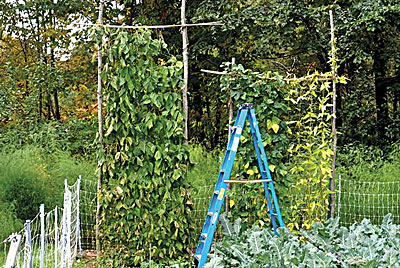|
|
| ‘Fortex’ (left, on a single trellis), ‘Big Mama’ (center) and ‘Liana’ (yard-long, right) pole beans and an 8-foot ladder. Pole beans are more productive than bush beans, have a longer harvest, and many are excellent both fresh and frozen. Photo by Adam Tomash. |
By Adam Tomash
Tired of getting inundated with loads of green beans that come in all at once? They taste OK canned, but that’s a lot of work. Frozen bush beans are tasteless mush. What to do?
Try pole beans. They produce for a much longer season but in much more manageable quantities – a good meal’s worth at every picking. Some varieties, such as ‘Fortex,’ are excellent for eating fresh and give a much better product frozen than the bush types. Even when a ‘Fortex’ bean is a foot long and as big around as a pencil, it is still very good eating, fresh or frozen.
The downsides to pole beans include the need for a ladder when they reach their full height of around 12 feet and, for ‘Fortex,’ attractiveness to Japanese beetles. I keep a ladder in place when the beans grow above easy reach or use a lightweight fiberglass ladder that can be moved easily. The beetle problem is solved by two sprays of a pyrethrin-based spray such as Pyganic® or Pyola® mixed with water and a spreader-sticker such as Crocker’s Fish Oil. This spray mix seems to deter feeding by the beetles for several weeks. Maybe it’s the fish oil? Don’t spray when bees are active. Surround is a deterrent if sprayed before the beetles appear. (Certified organic growers should check with their certifier before using insecticides.) Hand picking into a pail of soapy water works too but is tricky from an 8-foot ladder. Shaking the trellis vigorously twice a day also discourages Japanese beetles.
To ensure an early crop, especially during cold, wet springs as we had in 2009, when all my direct-seeded crops rotted in the ground, I start my bean plants in plug flats. I use the special, vertically grooved, deep plug flats used in forestry applications and sold by Park Seed as “Rootrainers” (www.beaverplastics.com/beavercurrent/rootrainer.html). They are well suited to the rooting habits of beans. I use my little temporary, compost-heated hoophouse to provide the bottom heat necessary for quick germination. (See https://www.mofga.org/resources/season-extension/grow-heat-loving-plants/)
Do not overwater or you invite disease problems. Rootrainers are expensive but last for many seasons and, as you can see at https://daughterofthesoil.blogspot.com/2009/01/rootrainers-and-bog-roll-tubes-some.html, are well worth it for difficult plants in difficult soils.
To make a trellis to hold the beans upright, I use two 12- to 14-foot saplings about 3 inches in diameter. Lay the two poles down in the garden so that their bottoms rest on either side of the proposed row and the distance apart is the width of the available trellis material. I favor the nylon Trellis Net® because it is light and strong. Staple or tie the trellis net to the poles. Spread the poles away from each other until the netting is taught. Thread a bamboo pole through the trellis net before raising it up. Then drive two stout iron “T” type fence posts into the ground so that they touch the base of the trellis poles. Get a helper to assist in raising the poles up so that they are vertical, and then attach the wooden poles to the iron fence posts with strong wire or rope. Lash the bamboo pole near the top of the wooden poles.
Plant beans at the base of the trellis by direct seeding or using the plug method described above. I start the seed in plug flats during the first week of June. Direct seeding must be done when the soil is warm, usually in the third week of June in central Maine.
About the author: Adam Tomash gardens in West Gardiner, Maine.

